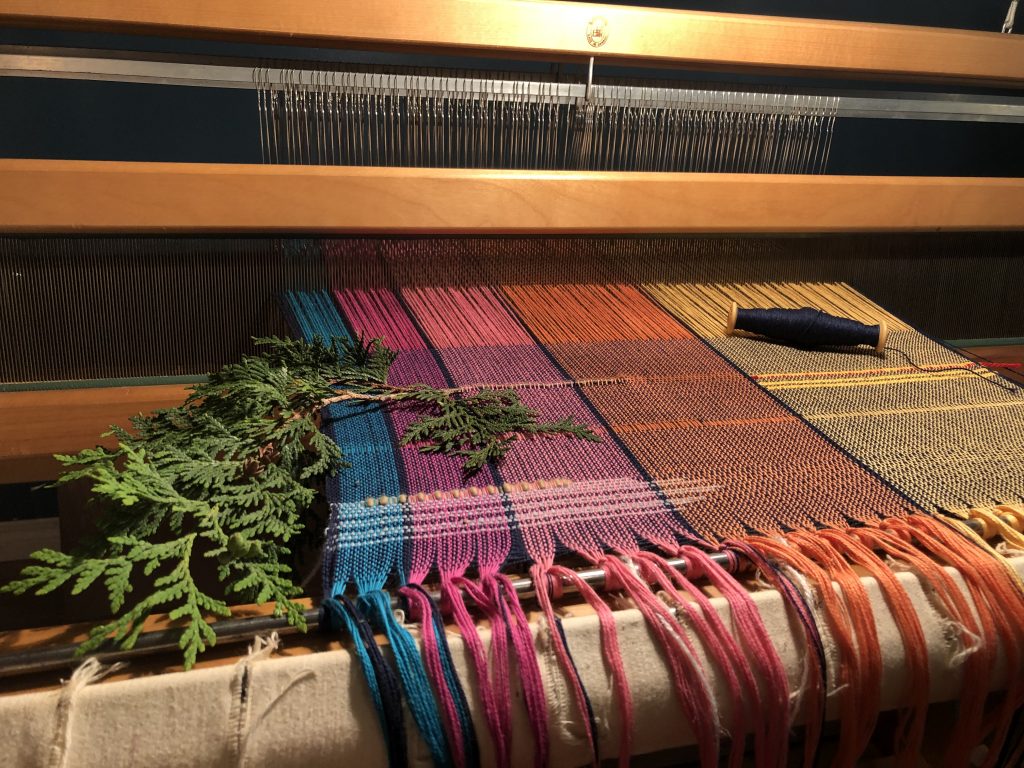Tacit Knowledge
Brigitte Champaigne-Klassen
Brigitte Champaigne-Klassen is a Master of Health Sciences student at Lakehead University specializing in Social-Ecological Systems, Sustainability & Health. With a background in environmental science field work, STEM education and interdisciplinary art, she is interested in exploring and re-conceptualizing different narratives of health through environmental justice, equity and creative expression.
Woven Threads, Woven Knowledge
Sunlight gently streams through the small oval window on your right. The cedars sway audibly outside as a spring storm brews over the lake. A mug of steaming coffee is perched on the windowsill. Your well-worn bench creaks as you sit down, almost like a sigh of relief that you are back.
Before you is your loom, prepped and ready to start weaving. You have already set up the warp—the vertical threads held under tension on the loom. The yarns have been methodically and evenly tied to the back of the loom, forming a blank canvas of thread for you.
If you tried to remember, you could probably think of most of the mentors who have helped you learn how to weave. Yet, there is no one grand moment of learning—this knowledge lives within you in a way that is unyielding to linear timelines and is impossible to chronicle fully in words. Instead, it is a circular and relational type of knowledge. Every time you sit down in front of your loom, you return to and build upon this knowledge. It comes together whenever you hold your threads. It is embodied within your mind, hands, body, and heart.
You reach for the green-coloured spool beside you without calculated thought. You don’t think about why you choose this one spool, nor do you anticipate how you’ll use it. You just pick it up and start weaving. You guide the spool between the intermeshed yarns that form the warp, change the shafts, and repeat. Slowly, line by line, the fabric before you builds into what will be a piece of cloth.
You start to reminisce about your grandmother and how she used to weave. You would wake up to the smell of freshly baked bread and the rhythmic thud of her loom. Her hands, smooth and wrinkled, seemed to gracefully fly across the loom as they painted the colourful threads into a woven fabric. Your eyes grew wide as you witnessed this magic silently from the doorframe, not wanting to disturb this woven rhythm. Once she noticed you, the sweet smell of cedar smoke would envelop you warmly as her long and strong arms pulled you close.

A faint aroma of cedar smoke seems to envelop you now as you remember her, and as the tapestry continues to grow before you, thread by thread. A rhythm builds and you feel connected to this process of making, of weaving, that is deeply formed by tacit knowledge. Words cannot easily express or codify how this piece of cloth you are creating came to be.
How can you express in words the context that guides your hands, memory, and body while you weave? Tacit knowledge, a compounding of wisdom, experience, feeling, intuition, and embodied experience, deeply directs how the fabric is made, given that “we can know more than we can tell” (Polanyi, 1966, p. 4).
Soon, the tacit knowledge that embeds and shapes your weaving will manifest into a long tapestry as the warp intertwines with the weft—the threads woven from side to side between the warp. When your weaving is complete, you will unfurl the totality of your creation, cut the yarns at the end of your loom, and watch your tapestry drape before you.
You will share this with a friend, a partner, a community elder. They will hold the tapestry and see this creation. The weight and the softness of the woven threads will be felt between their hands. They will hold an explicit product of knowledge of your weaving, an output. Yet, while they might hold the fabric, they will never know all that has directed its creation. All they might see and feel is the explicit piece of cloth. This fabric expresses tacit knowledge in a material way that you can hold, see, touch, and smell, yet never fully know.
As you watch the person hold your woven creation, you know more than you can tell. You cannot fully express the array of tacit knowledge that directed the making of this woven piece that has involved so much more than technical skill. Yet, it does not mean that the tacit knowledge you embody exists any less.
Weaving is a canvas on which tacit knowledge is woven into thread, where your current ways of being and knowing form the woven fabric in front of you. This includes all the accumulated contexts that have led to your experience, intuition, ancestral knowledge, wisdom… Tacit knowledge lies within the weft and warp of your threads, a material representation of your own embodied making.
Discussion Questions
- This vignette uses weaving to explore tacit knowledge. What are other examples or forms of tacit knowledge? How does tacit knowledge have an impact in your life today?
- Given that tacit knowledge cannot fully be described in words, is tacit knowledge a less valid form of knowledge than more explicit forms? Why or why not?
- Could you prove tacit knowledge exists, and does proving the existence of tacit knowledge matter? How and why is tacit knowledge valuable?
Additional Resources
Polanyi, M. (1966). The tacit dimension. Chicago, IL: The University of Chicago Press.
Smith, L. T. (2012). Decolonizing methodologies: Research and indigenous peoples. Zed Books Ltd.
Wilson, S. (2008). Indigenous research methods. Fernwood Publishing, Halifax, 2008.

